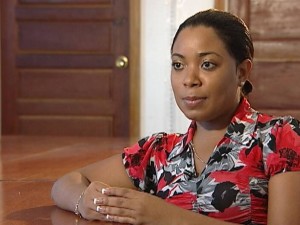Healthy Living trims the fat
 How Healthy is Belize? That’s the question we ask tonight on Healthy Living. It’s a major concern for our growing population that is relying more and more on fast food, yet exercising less. In fact, more than half of the population is well over the appropriate weight.
How Healthy is Belize? That’s the question we ask tonight on Healthy Living. It’s a major concern for our growing population that is relying more and more on fast food, yet exercising less. In fact, more than half of the population is well over the appropriate weight.
It is no secret that Belize’s population is not at its healthiest. In the previous years we’ve seen an increase in food options, with a wide array of quick and easy takeout meals and a decrease in physical activity as most people shuttle about in vehicles and busses to work indoors and behind a desk. But just how unhealthy are we? According to Ministry of Health’s Nutritionist, at last count, Belizeans were 60% overweight & obese.
Robyn Daly, Nutritionist, Ministry of Health
“We have over sixty-percent of the population either overweight or obese which is bad. Our population is small as it is. When we look in terms of diabetes we’re looking at like thirteen percent of the population having and these numbers that I am giving you are from a study done in 2005 so you can imagine what it’s like 5 years later. So it’s safe to say that the numbers have increased. We can make that assumption. When we look at high blood pressure as well we can see again more than forty percent of the population suffering from high blood pressure. And again we can see teenagers, middle aged, and right up to older persons. When we look at number one cause of death that is health reasons we see that diabetes is being on top.”
 The statistics Daly referred to were a part of a study conducted in 2005 assessing diabetes, hypertension and their risk factors. The study also indicated that Creoles, Mestizos and Mixed populations were more likely to be overweight. Also, that women were more obese than men in all age groups and even more so women in Corozal were more likely to be overweight or obese. Men however, we’re at greater risk for high blood pressure and this is attributed to additional risk factors like drinking and smoking. Food choices and sparse physical activity are the main underlying factors.
The statistics Daly referred to were a part of a study conducted in 2005 assessing diabetes, hypertension and their risk factors. The study also indicated that Creoles, Mestizos and Mixed populations were more likely to be overweight. Also, that women were more obese than men in all age groups and even more so women in Corozal were more likely to be overweight or obese. Men however, we’re at greater risk for high blood pressure and this is attributed to additional risk factors like drinking and smoking. Food choices and sparse physical activity are the main underlying factors.
Robyn Daly
“We look at nearly seventy-five percent of the population getting less than sixty seconds of physical activity for the week. And everybody could probably answer that for themselves. They say ‘well i could do a bit more’ ‘there is more that I could do but I don’t have time.’ you know that we are not as active as before so that’s one main problem that we need to work on. We need to become more active. The amounts of food that we are having in relation the exercise. Its safe to say we use to be more active and food we didn’t have as much food. So when you balance those two out the weight and all these other conditions wasn’t a big problem back then but now we’re eating much more. Our preparation is different. We’re actually adding much more fats, harmful fats might I add and we’re actually eating more and we’re doing very, very little in terms of physical activity.”
 And this becomes the beginning of a harmful cycle.
And this becomes the beginning of a harmful cycle.
Robyn Daly
“Just being overweight is a risk factor for all three conditions. So again its like a cycle we’re going through. So you’re overweight you’re at risk for diabetes, you’re at risk for high blood pressure you’re at risk for heart disease. You don’t control being overweight you develop a heart condition. Then again on how you’re eating if it’s being managed properly or it can get worse.”
This is why the Ministry of Health and PAHO have launched an offensive on this problem. Caribbean Wellness Week is celebrated once a year in September in hopes of reducing the epidemic of non-communicable diseases. This year, via their Wellness Program, the Ministry of Health is starting in-house.
Robyn Daly
“One good way to encourage is to have group initiatives. I find that working out very well instead of doing it alone. So having activities in the workplace, getting together team efforts to work on this new healthy lifestyle concept and its becoming the trend now and I think it is very effective cause people are taking action together.”
Rose Anderson, Health Educator, Western Health region
“Well the blood pressure was 120/80 the glucose was ninety-three and BMI was a little bit was four points over normal.”
Rose is educates people daily on healthy living. But that does not exclude her from facing the same difficulties an average person faces in being healthy. She pinpoints food choices as her problem.
Rose Anderson
“Whenever we have to purchase food. If we don’t cook our own food we have to find food that you know that a person that is on a diet you cannot find that readily available out there. And if you do it is very expensive.”
Robyn Daly
“What we’re looking at to encourage people to do is to make small steps. We’re looking at moderation , people need to bridge that gap between what’s too much and what’s too little, people need to be knowledgeable of how much is too much. What is an acceptable amount?”
 The employees have three months to execute their healthy living when the program concludes with their final weigh in. MOH is encouraging organizations, schools or other groups to get involved by starting similar initiatives.
The employees have three months to execute their healthy living when the program concludes with their final weigh in. MOH is encouraging organizations, schools or other groups to get involved by starting similar initiatives.
Robyn Daly
“Many people don’t want to change their eating habits they don’t want to change to take time out to exercise and to read up about the things we should be doing and actually do them. Worst case scenario is that we’re looking at a weak and very unhealthy population which is not what we want. We’re growing our population is growing and we’re trying to ensure that we’re growing in the right way as well.”




MODERATION………………………….. in EVERYTHING.